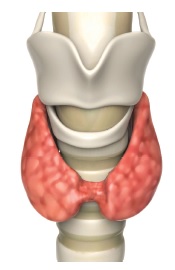Graves’ Disease and Thyroid Stimulating Immunoglobulins: An Improved Diagnostic Tool?
 Graves’ disease, one of the most common forms of hyperthyroidism, has an incidence of approximately 5 in 10,000 people per year, affecting 13 million, and targets women seven times as often as men (1). Graves’ disease is an autoimmune disorder caused by the presence of thyroid-stimulating immunoglobulins (TSI) that bind to the TSH receptor on the thyroid cells and stimulate the uncontrolled production of thyroid hormone.
Graves’ disease, one of the most common forms of hyperthyroidism, has an incidence of approximately 5 in 10,000 people per year, affecting 13 million, and targets women seven times as often as men (1). Graves’ disease is an autoimmune disorder caused by the presence of thyroid-stimulating immunoglobulins (TSI) that bind to the TSH receptor on the thyroid cells and stimulate the uncontrolled production of thyroid hormone.
Although the presence of TSI in the serum of patients known to have Graves’ disease is significant to the disease, the direct screening for this autoantibody has not been used as a primary tool in its diagnosis. Rather, the diagnosis is typically derived from the clinical history, the physical examination and a panel of diagnostic tests, which includes the measurement of serum levels of thyroid stimulating hormone (TSH), triiodothyronine (T3), and thyroxine (T4) or free T4. This has been the case because the direct measurement of TSI is relatively complex (tissue culture followed by radioimmunoassay), is relatively expensive, has a longer turn-around time, and is subject to some assay interferences. Nonetheless, detecting the presence of TSI in the blood can be a powerful diagnostic tool for the differential diagnosis of Graves’ disease (2).
 TSI measurements are also used to monitor the response to Graves’ disease therapy (3), predication of remission or relapse (4), confirmation of Graves’ ophthalmopathy (5), and prediction of hyperthyroidism in neonates (6). Incorporating a TSI assay into existing diagnostic algorithms has been shown to reduce overall direct costs of Graves’ disease diagnosis by up to 43%, with the net cost of avoiding misdiagnosis reduced by up to 85% (7).
TSI measurements are also used to monitor the response to Graves’ disease therapy (3), predication of remission or relapse (4), confirmation of Graves’ ophthalmopathy (5), and prediction of hyperthyroidism in neonates (6). Incorporating a TSI assay into existing diagnostic algorithms has been shown to reduce overall direct costs of Graves’ disease diagnosis by up to 43%, with the net cost of avoiding misdiagnosis reduced by up to 85% (7).
Recently, an automated semi-quantitative assay, which detects only TSI, the specific cause of Graves’ disease pathology, has become available (8). The manufacturer evaluated serum samples from 361 treated and untreated hyperthyroid Graves’ disease patients, and 404 individuals with other thyroid or autoimmune diseases. At a cut-off of 0.55 IU/L, the clinical sensitivity and specificity for Graves’ disease were 98.6% and 98.5% respectively. In comparison, the clinical sensitivity and specificity of the current tissue culture/radioimmunoassay procedure is 92.0% and 99.4%, with 7.6% invalid (null) results (9).
The clinical sensitivity and specificity of assays can, at times, appear to be abstract or confusing. Let me share two clinical examples from our in house analytical validation.
Patient #1: Currently demonstrating clinical symptoms of hyperthyroidism. TSH = <0.01 mIU/L (reference range: 0.4 – 4.5 mIU/L), free T4 = 1.25 ng/dL (reference range: 0.8 – 1.8 ng/dL), free T3 = 3.7 pg/mL (reference range: 2.3 -4.2 pg/mL). Thus, this patient is clinically symptomatic, has a low TSH, but a normal free T4 and free T3. Follow up studies were TSI by bioassay = <89 % of baseline (reference range: <140%), thyroid scan: consistent with Graves’ disease. Final clinical diagnosis: Graves’ disease. TSI by chemiluminescence = 0.925 IU/L (>0.55 IU/L is consistent with Graves’ disease.)
Patient #2: Currently asymptomatic. Referred to an endocrinologist for low TSH and presumed subclinical hyperthyroidism. TSH = 0.01 mIU/L (reference range: 0.4 – 4.5 mIU/L), free T4 = 2.53 ng/dL (reference range: 0.8 – 1.8 ng/dL). Follow up studies were ultrasound, which showed a slightly enlarged thyroid and TSI by bioassay: <89 % of baseline (reference range: <140%). Final clinical diagnosis: “goiter”. TSI by chemiluminescence = 7.98 IU/L (>0.55 IU/L is consistent with Graves’ disease).
We believe that the TSI assay by chemiluminescence accurately confirms the diagnosis of Graves’ disease in Patient #1 and strongly suggests the development of Graves’ disease in Patient #2, despite the normal TSI bioassay. The use of this new direst TSI assay can make the differential diagnosis of Graves’ disease faster and easier, allowing patients to be diagnosed and treated sooner.
This assay is available from Warde Medical Laboratory as Test Code TSI, effective June 28, 2016.
- AARDA, American Autoimmune Related Disease Association; NWHIC, National Women’s’ Health Information Center.
- J. Ginsberg, Diagnosis and management of Graves’ disease, Canad. Med. Assoc. J., 168(5): 575-585, 2003.
- P. Laurberg, G. Wallin, L. Tallstedt, M. Abraham-Nordling, G. Lundell, O. Torring, TSH-receptor autoimmunity in Graves’ disease after therapy with anti-thyroid drugs, surgery, or radioiodine: a 5-year prospective randomized study, Euro. J. Endocrinol., 158:69-75, 2008.
- C. Giuliani, D. Cerrone, N. Harii, M. Thornton, L.D. Kohn, N.M. Dagia, I. Bucci, M. Carpentieri, B. Di Nenno, A. Di Blasio, P. Vitti, F. Monaco, G. Napolitano, A TSHR-LH/CGR chimera that measures functional thyroid-stimulating autoantibodies (TSAb) can predict remission or recurrence in Graves’ patients undergoing antithyroid drug (ATD) treatment, J. Clin. Endocrinol. Metab., 97(7):E1080-E1087, 2012.
- A.K. Eckstein, M. Plicht, H. Lax, M. Neuhauser, K. Mann, S. Lederbogen, C. Heckmann, J. Esser, N.G. Morgenthaler, Thyrotropin receptor autoantibodies are independent risk factors for Graves’ ophthalmopathy and help to predict severity and outcome of the disease, J. Clin. Endocrinol. Metab., 91(9):3464-3470,2006.
- M.R. Bjorgaas, H. Farstad, S.C. Christiansen, H-G.K. Blaas, Impact of thyrotropin receptor antibody levels on fetal development in two successive pregnancies in a woman with Graves’ disease. Horm. Res. Paediatr., 79:39-43, 2012.
- McKee A, Peyerl F. TSI assay utilization: impact on costs of Graves' hyperthyroidism diagnosis. AJMC. 2012;18(1):1-15.
- www.siemens.com/press/PR2015100019HCEN
- Package insert, Thyretain TSI Reporter Bioassay,Diagnostics Hybrids, Athens, Ohio (2009).

